Synovus Bundle
What's Next for Synovus Financial Corp.?
From its roots in community banking to its modern-day presence, Synovus Financial Corp. has consistently adapted and evolved. This evolution, marked by strategic milestones like pioneering the credit card business and becoming Georgia's first bank holding company, sets the stage for a deeper dive. Now, let's explore the Synovus SWOT Analysis to understand its current standing.
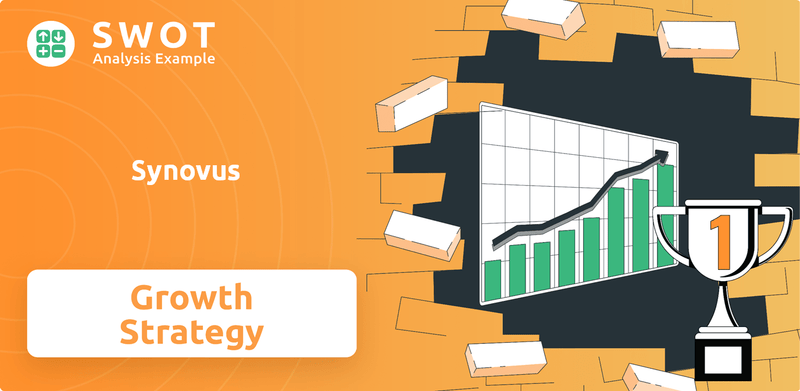
Synovus's growth strategy is focused on expanding its footprint and enhancing its financial performance. Understanding the Synovus future prospects requires a detailed look at its Synovus company analysis, including its Synovus market position and Synovus strategic initiatives. The company's commitment to investing in technology and digital capabilities will likely be a key driver of its Synovus revenue growth trends and overall success in the coming years.
How Is Synovus Expanding Its Reach?
The company is actively pursuing several expansion initiatives to drive future growth. Its strategic plan for 2025 emphasizes accelerated investments in key areas. This strategy aims to enhance its market position and capitalize on emerging opportunities within the financial sector. The focus is on sustainable growth and increasing shareholder value.
The company's expansion strategy includes significant investments in its core business lines. The company is targeting end-of-period loan growth of 3% to 6% and core deposit growth of 3% to 6% in 2025. This growth is expected to come from various sectors, including middle market banking, specialty lending, and corporate and investment banking. These initiatives are designed to broaden its customer base and increase its market share.
The company's expansion efforts are supported by investments in technology and specialized services. These investments aim to improve operational efficiency and enhance the customer experience. The company’s approach is to provide comprehensive financial solutions. The company is focused on long-term growth potential.
Wholesale banking saw significant growth in the first quarter of 2025. New loan fundings reached $900 million. This represents a 35% increase from the prior April average. The loan pipeline is up over 100% from the same period last year. It exceeds $1 billion, indicating strong demand and future growth potential.
The company has expanded its branch operations across five states. These states include Georgia, Alabama, Florida, South Carolina, and Tennessee. This expansion allows the company to serve a broader customer base. It also increases market share within these key regions. This strategic move supports long-term growth.
The company offers a full suite of specialized products and services. These include wealth services, treasury management, and mortgage services. Other services are premium finance, asset-based lending, and structured lending. Capital markets and international banking are also part of the offerings. This diversification strategy aims to offer comprehensive financial solutions.
The company generated a 4% increase in core commercial loans in 2024. This growth was seen in middle market, corporate and investment banking, and specialty lending. Core deposits increased by 3% in 2024. This was achieved through focused sales efforts and product expansion. The introduction of a new legal deposit vertical and a small business bundle contributed to this growth.
The company's expansion strategy is multifaceted, encompassing both organic growth and strategic investments. The company is focused on enhancing its revenue streams through a combination of geographic expansion, product diversification, and technological advancements. These initiatives are designed to strengthen its market position and drive long-term sustainable growth. The company's strategic initiatives are aimed at improving its financial performance. The company's focus on customer acquisition strategies is also vital.
The company is concentrating on several key areas to achieve its growth objectives. These include expanding its digital banking strategy and investing in technology. The company also focuses on mergers and acquisitions strategy. The company is committed to sustainable banking practices.
- Middle Market Banking: Expanding services and customer base.
- Specialty Lending: Growing specialized lending products.
- Corporate and Investment Banking: Enhancing services for corporate clients.
- Digital Banking: Investing in technology to improve customer experience.
Synovus SWOT Analysis
- Complete SWOT Breakdown
- Fully Customizable
- Editable in Excel & Word
- Professional Formatting
- Investor-Ready Format
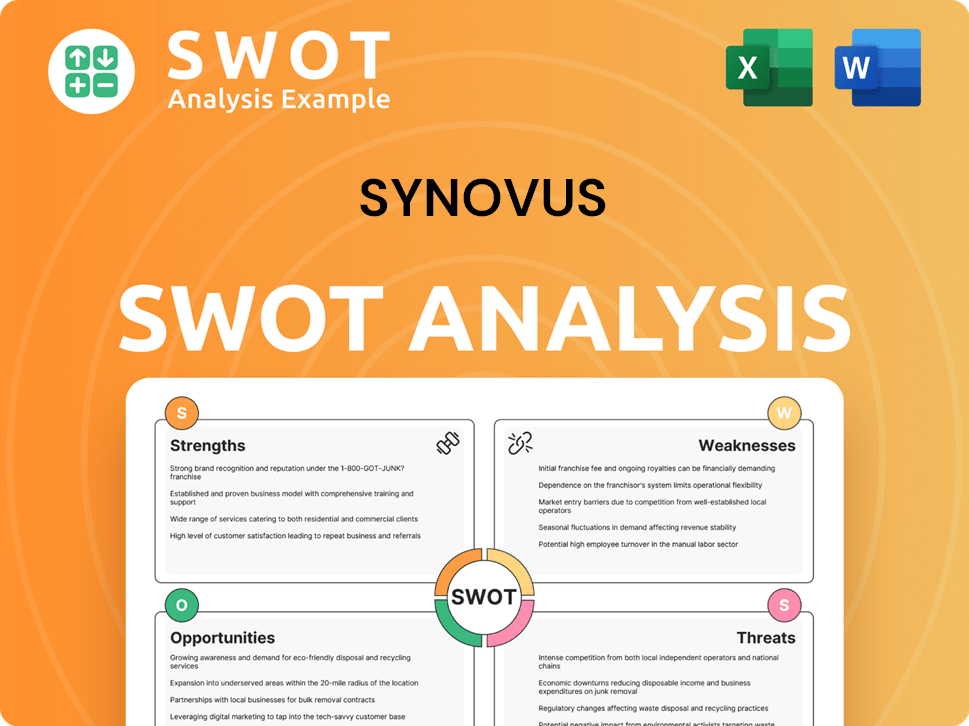
How Does Synovus Invest in Innovation?
The company is heavily invested in leveraging technology and innovation to drive its Synovus growth strategy, focusing on digital transformation and enhancing client experiences. This approach involves significant investments in technology and digital platforms to streamline operations and improve service delivery. The appointment of key personnel, such as Katie Webb as chief consumer digital and client experience officer in January 2025, underscores the commitment to integrating physical and digital channels and developing new digital capabilities.
The core of this strategy is a digital transformation initiative, which includes intentional technology integration across the organization. This integration aims to enhance operations, improve employee functions, and optimize customer interactions. The company is actively investing in digital banking platforms, mobile applications, and data analytics. These investments are designed to provide convenient, secure, and personalized financial solutions for clients.
Furthermore, the company is exploring cutting-edge technologies like AI, quantum computing, and virtual/augmented reality to streamline and scale operations. CEOs at the company believe that generative AI, in particular, will improve workflow and process efficiencies, ultimately increasing profitability and revenue. Some of these benefits are already being observed within the organization.
The company is prioritizing digital transformation to enhance operational efficiency and customer experience. This includes investments in digital banking platforms and mobile applications.
The company is exploring and implementing AI, quantum computing, and virtual/augmented reality to streamline operations. Generative AI is expected to improve workflow and boost profitability.
The company leverages data analytics and AI to provide personalized financial solutions. This includes AI-driven insights and personalized engagement strategies.
Partnerships, such as the one with Personetics, highlight the company's commitment to data-driven insights and personalized engagement. The bank is expanding personalized guidance capabilities.
The company is focused on improving client experience through digital channels and personalized financial solutions. This includes creating a 'virtual financial advisor' for every client.
The appointment of key executives, like the chief consumer digital and client experience officer, demonstrates a commitment to digital transformation and strategic leadership.
The partnership with Personetics is a prime example of the company's commitment to data-driven insights and personalized engagement. The bank has deployed over 60 AI-driven insights. Approximately 20% of its over 300,000 digital users are highly engaged with these insights and advice. This has resulted in positive outcomes, such as engaged users experiencing higher deposit growth (7% versus 4%) and an increase in product cross-sell. Looking ahead, the company plans to expand these personalized guidance capabilities to create an interactive 'virtual financial advisor' for every client, further enhancing its Synovus future prospects. To understand the specific customer segments the company targets, you can read more in this article: Target Market of Synovus.
The company's approach to technology and innovation encompasses several key strategies focused on digital transformation, AI integration, and enhanced customer experience.
- Digital Banking Platforms: Investing in digital banking platforms to provide convenient and secure services.
- Mobile Applications: Developing and enhancing mobile applications to improve customer accessibility and engagement.
- Data Analytics: Utilizing data analytics to offer personalized financial solutions and insights.
- AI and Emerging Technologies: Exploring and implementing AI, quantum computing, and virtual/augmented reality to streamline operations.
- Partnerships: Collaborating with companies like Personetics to leverage data-driven insights and personalized engagement.
- Virtual Financial Advisor: Planning to create an interactive 'virtual financial advisor' for every client to provide personalized guidance.
Synovus PESTLE Analysis
- Covers All 6 PESTLE Categories
- No Research Needed – Save Hours of Work
- Built by Experts, Trusted by Consultants
- Instant Download, Ready to Use
- 100% Editable, Fully Customizable
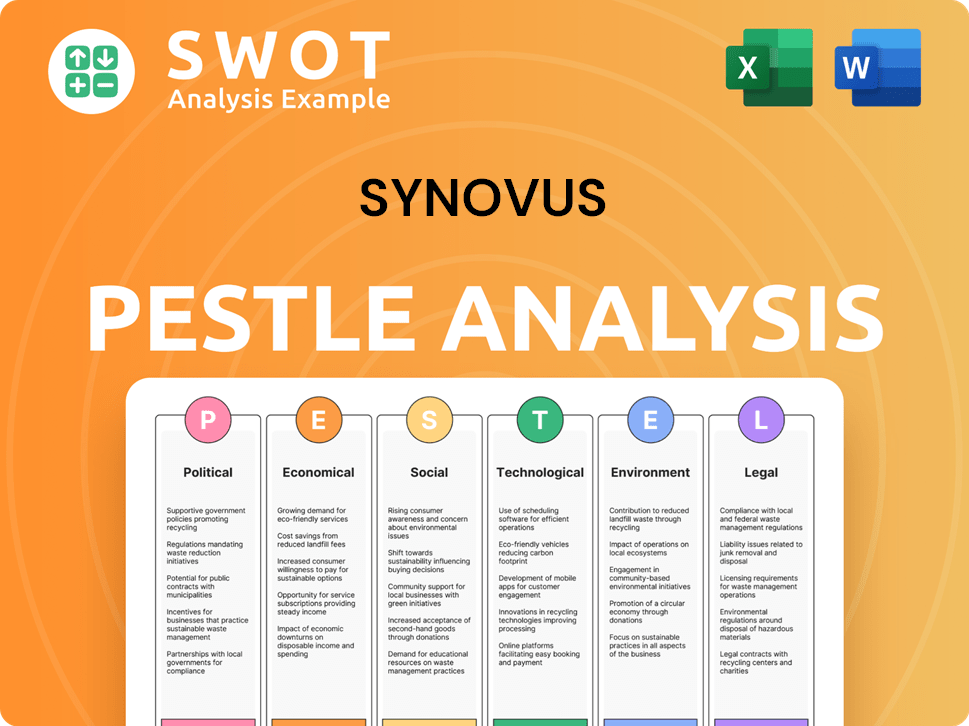
What Is Synovus’s Growth Forecast?
The financial outlook for Synovus reflects a strong performance in 2024 and promising projections for 2025. The company's Synovus growth strategy and Synovus future prospects are centered on sustained profitability and strategic expansion. This Synovus company analysis highlights key financial metrics and future plans, providing a comprehensive view of its financial health and strategic direction.
In 2024, Synovus demonstrated robust Synovus financial performance. Revenue reached $2.38 billion, marking a significant 28.48% increase from the previous year. Earnings per share (EPS) also saw a substantial rise, increasing by 60.41% to $4.86. These figures underscore the company's ability to drive revenue growth and enhance profitability, positioning it favorably in the competitive landscape.
Looking ahead to 2025, Synovus anticipates continued growth. The company projects an adjusted revenue growth between 3% and 7%, alongside end-of-period loan growth and core deposit growth of 3% to 6%. These projections indicate a balanced approach to expansion, focusing on both revenue and deposit growth. For a deeper dive into the company's performance, consider reading about Owners & Shareholders of Synovus.
In 2024, Synovus reported a revenue of $2.38 billion, a 28.48% increase from the previous year. The company's EPS reached $4.86, marking a 60.41% increase, reflecting strong financial performance.
For 2025, Synovus projects adjusted revenue growth between 3% and 7%. The company also anticipates end-of-period loan growth and core deposit growth of 3% to 6%, indicating a focus on sustainable growth.
In the first quarter of 2025, diluted EPS surged 67% year-over-year to $1.30. Net income available to common shareholders rose to $183.7 million, a 60% increase from the previous year.
Net interest income reached $454 million, an 8% year-over-year increase. The net interest margin expanded to 3.35%, indicating strong financial health and profitability.
Synovus is focused on maintaining a stable CET1 ratio and leveraging share repurchases. The capital plan for 2025 includes a quarterly dividend of $0.39 per share and authorized share repurchases of up to $400 million of common stock and $50 million of preferred stock.
- The efficiency ratio improved to 53.81%, indicating better cost management.
- The company's strategic initiatives include a focus on digital banking and customer acquisition.
- Synovus is also considering mergers and acquisitions as part of its growth strategy.
- The company is committed to sustainable banking practices and community impact initiatives.
Synovus Business Model Canvas
- Complete 9-Block Business Model Canvas
- Effortlessly Communicate Your Business Strategy
- Investor-Ready BMC Format
- 100% Editable and Customizable
- Clear and Structured Layout
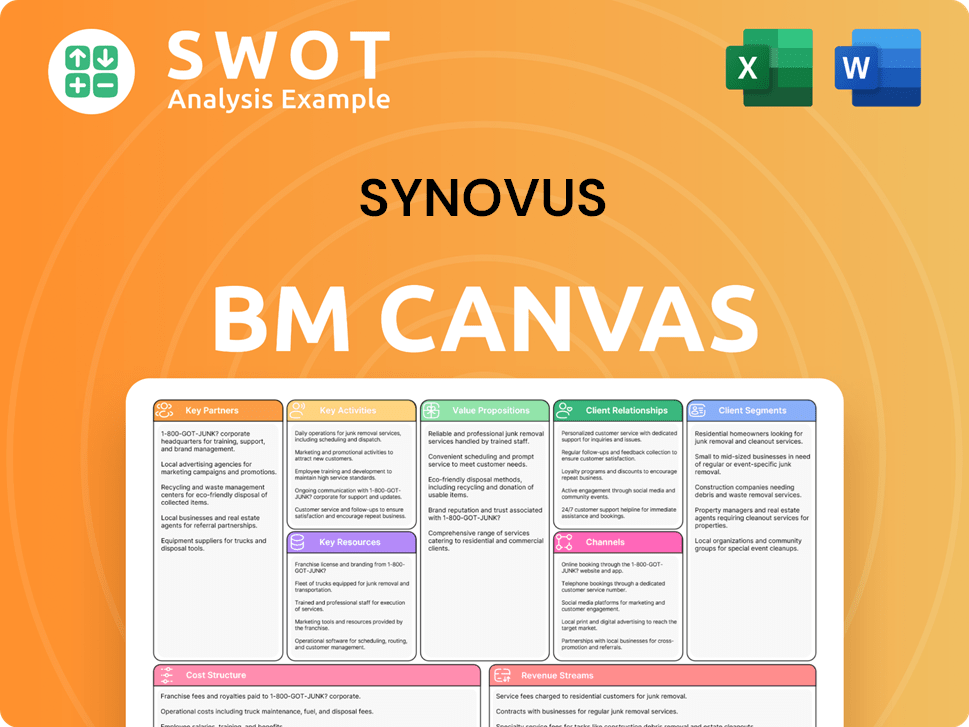
What Risks Could Slow Synovus’s Growth?
The path ahead for Synovus faces several potential risks and obstacles that could influence its Synovus growth strategy and overall Synovus future prospects. The financial services industry is highly competitive, with both traditional banks and fintech companies vying for market share. This intense competition can lead to pressure on margins, affecting Synovus financial performance.
Regulatory changes also pose a significant challenge. As a financial institution, Synovus is subject to extensive federal and state regulations, and any shifts in this landscape could increase compliance costs and affect business operations. Market risks, such as interest rate fluctuations, can also impact net interest income and the value of financial assets, even with risk mitigation strategies in place.
Understanding these potential pitfalls is crucial for a comprehensive Synovus company analysis. The ability to navigate these challenges will be key to the company's long-term success and its ability to execute its Synovus strategic initiatives effectively.
The financial services industry is intensely competitive, with traditional banks and non-bank financial institutions, including fintech companies, vying for market share. This competition can lead to pressure on margins due to competitive loan pricing. Analyzing the Synovus competitive landscape analysis is crucial for understanding these pressures.
Regulatory changes present a significant risk for Synovus. Increased compliance costs and operational impacts could arise from shifts in the regulatory environment. The Corporate Transparency Act (CTA) and its reporting requirements are areas to monitor, with potential for reinstatement of reporting obligations for domestic entities.
Market risks, such as interest rate fluctuations, can affect net interest income and the value of financial assets, even with hedging strategies in place. The economic environment, including inflationary pressures and geopolitical tensions, adds to market uncertainty. Client sentiment has shown some deterioration, with 17% of commercial clients expecting reduced business activity in Q1 2025, a 7-percentage-point rise from Q4 2024.
Synovus faces near-term challenges in loan growth, with industry-wide loan growth expected to be flat or modest until the second half of 2025. Risks associated with commercial real estate loan maturities are also a concern. These factors could impact the company's ability to achieve its Synovus revenue growth trends.
Cyber and data security risks pose a significant threat, potentially leading to reputational harm and financial liabilities. Protecting customer data and maintaining operational integrity are critical. Addressing these risks is essential for Synovus's long-term growth potential and maintaining customer trust.
The economic environment, including inflationary pressures and geopolitical tensions, adds to market uncertainty. Trade policy uncertainty, including potential impacts from higher tariffs, could influence future performance. These external factors require careful monitoring and strategic adaptation. For a deeper understanding, you can explore the Competitors Landscape of Synovus.
Interest rate fluctuations can significantly impact Synovus's financial performance. Rising rates can increase the cost of borrowing, affecting loan demand and profitability. Conversely, falling rates can compress net interest margins. The company's ability to manage these risks through hedging and other strategies is crucial for maintaining Synovus profitability outlook. Effective risk management is a key component of Synovus's risk management strategies.
Client sentiment and the broader economic outlook can influence Synovus's growth. Deteriorating client sentiment, as seen with 17% of commercial clients expecting reduced business activity in Q1 2025, poses a risk. Economic downturns can lead to increased loan defaults and reduced demand for financial services. Monitoring these trends is essential for adapting Synovus's customer acquisition strategies and overall Synovus market position.
Synovus Porter's Five Forces Analysis
- Covers All 5 Competitive Forces in Detail
- Structured for Consultants, Students, and Founders
- 100% Editable in Microsoft Word & Excel
- Instant Digital Download – Use Immediately
- Compatible with Mac & PC – Fully Unlocked
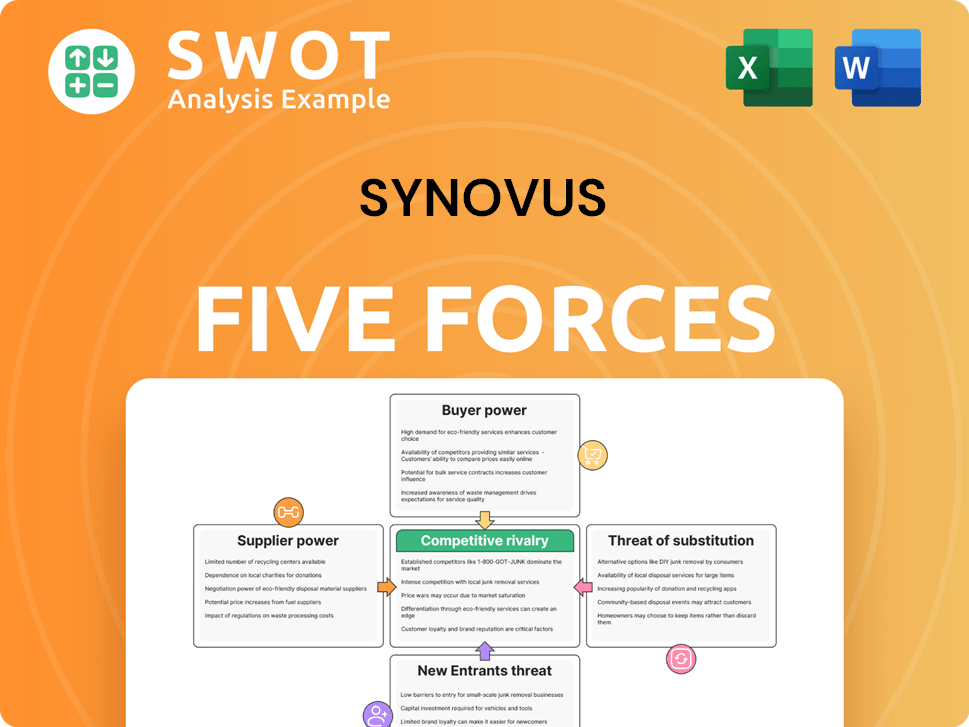
Related Blogs
- What are Mission Vision & Core Values of Synovus Company?
- What is Competitive Landscape of Synovus Company?
- How Does Synovus Company Work?
- What is Sales and Marketing Strategy of Synovus Company?
- What is Brief History of Synovus Company?
- Who Owns Synovus Company?
- What is Customer Demographics and Target Market of Synovus Company?
Disclaimer
All information, articles, and product details provided on this website are for general informational and educational purposes only. We do not claim any ownership over, nor do we intend to infringe upon, any trademarks, copyrights, logos, brand names, or other intellectual property mentioned or depicted on this site. Such intellectual property remains the property of its respective owners, and any references here are made solely for identification or informational purposes, without implying any affiliation, endorsement, or partnership.
We make no representations or warranties, express or implied, regarding the accuracy, completeness, or suitability of any content or products presented. Nothing on this website should be construed as legal, tax, investment, financial, medical, or other professional advice. In addition, no part of this site—including articles or product references—constitutes a solicitation, recommendation, endorsement, advertisement, or offer to buy or sell any securities, franchises, or other financial instruments, particularly in jurisdictions where such activity would be unlawful.
All content is of a general nature and may not address the specific circumstances of any individual or entity. It is not a substitute for professional advice or services. Any actions you take based on the information provided here are strictly at your own risk. You accept full responsibility for any decisions or outcomes arising from your use of this website and agree to release us from any liability in connection with your use of, or reliance upon, the content or products found herein.